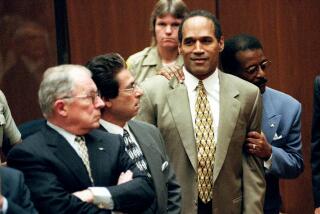King Trial Too Big for Such a Small Courtroom
- Share via
A big sign reading “Public Keep Out” should be posted on the Edward Roybal Federal Building, where four cops are being tried on civil rights charges in the beating of Rodney G. King.
That’s the message coming from the eighth-floor courtroom of U.S. District Judge John G. Davies, who is presiding over the trial. Washington has been generous in spending for wood paneling and a massive, dark-colored, polished stone wall in back of the judge. But federal authorities found space and funds for just four rows of benches for Angelenos who want to see the trial of the year.
To be fair, there are four and a half rows. A few temporary seats have been put against the back wall. Most of the room is occupied by court attaches, attorneys, the jury and the judge, high atop his bench. The room is all playing field, with not enough room for the stands.
Larger courtrooms can be found in the nearby old federal building. But the judge chose to remain in his new courtroom. I can see why Judge Davies, who was forced to move to the new building when it opened in December, might hesitate to ask his staff to drag themselves and their records back across the street. But the alternative has been to add an unpleasant note of privacy--even mystery--to proceedings that should be wide open to the public.
That’s particularly bad in this case where white cops were found not guilty of beating an African-American in the state trial. That verdict feeds the suspicions of members of the African-American community who are convinced that the criminal justice system is stacked against them.
Only about 15 seats in the courtroom are available to the public. The rest are for friends, relatives and helpers of the prosecution and defense, and for reporters covering the trial.
Only a handful of journalists receive the yellow badges permitting them inside the courtroom. Our paper, like the other news operations, has one for the reporter writing daily stories. Other reporters sit in a press room two floors below the court, listening to the proceedings on a sound system of exceedingly poor quality. In the last two days, I was in the court for 20 minutes on a pass borrowed from a colleague. All I could see were the backs of the lawyers. A sports-bar sized television set, presumably to show the famous video, blocked the judge from my view.
I’m not whining about my lousy working conditions. Personally, the sound-only press room is fine with me.
I’m a child of the radio age, part of a generation that learned to imagine faces and scenes to go with the voices that boomed out of our Motorolas and Philcos.
Unable to see Judge Davies, I could picture him. He sounded irritable, the kind of man you don’t want to cross. Perhaps in later years he’ll indulge himself in famous flights of temper from the bench, like his elderly colleague, Federal Judge Andrew Hauk.
In my mind, I could see the defense lawyers bustling around furiously, full of the cunning and outrage they’d learned as rookies in the lower courts. The federal prosecutors had the solemn voices of serious people climbing the Justice Department career ladder.
So, as I said, I have no complaints. Or least, I had none until the speaker system went temporarily silent Tuesday morning, and we in the press missed some testimony. At that moment, my imagination failed me. I had no idea what was happening in the courtroom.
The brief breakdown pointed up what’s wrong with the federal court’s policy.
The flow of information from the Roybal building travels along too narrow a path.
A bigger courtroom would have allowed many more spectators, observers from groups with influence in the city. More room for the press would have allowed a greater variety of stories, from large numbers of publications, big and small, representing every point of view. Daily live television coverage would have brought the trial into every home.
Granted, we had a riot after the first trial, every moment of which was televised live. But go back in history and you’ll find that more times than not, a shortage of information breeds suspicion and trouble.
Federal authorities should have thought of that. This trial, and the upcoming trial of the young African-American men accused of beating white truck driver Reginald O. Denny, will have an impact on the peace and safety of Los Angeles and the surrounding communities.
This isn’t saying we’ll have post-trial riots. But you don’t have to be a fortune teller or a doomsayer to know things will be tense.
Getting all the facts doesn’t prevent trouble. But ignorance is more dangerous. Only a public that’s had access to all the information can judge whether the current trial is fair.
More to Read
Sign up for Essential California
The most important California stories and recommendations in your inbox every morning.
You may occasionally receive promotional content from the Los Angeles Times.












